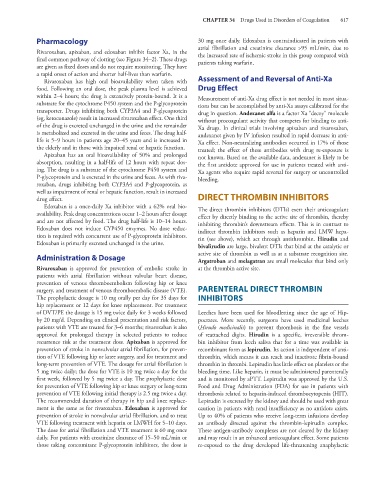Page 631 - Basic _ Clinical Pharmacology ( PDFDrive )
P. 631
CHAPTER 34 Drugs Used in Disorders of Coagulation 617
Pharmacology 30 mg once daily. Edoxaban is contraindicated in patients with
atrial fibrillation and creatinine clearance >95 mL/min, due to
Rivaroxaban, apixaban, and edoxaban inhibit factor Xa, in the the increased rate of ischemic stroke in this group compared with
final common pathway of clotting (see Figure 34–2). These drugs patients taking warfarin.
are given as fixed doses and do not require monitoring. They have
a rapid onset of action and shorter half-lives than warfarin.
Rivaroxaban has high oral bioavailability when taken with Assessment of and Reversal of Anti-Xa
food. Following an oral dose, the peak plasma level is achieved Drug Effect
within 2–4 hours; the drug is extensively protein-bound. It is a Measurement of anti-Xa drug effect is not needed in most situa-
substrate for the cytochrome P450 system and the P-glycoprotein tions but can be accomplished by anti-Xa assays calibrated for the
transporter. Drugs inhibiting both CYP3A4 and P-glycoprotein drug in question. Andexanet alfa is a factor Xa “decoy” molecule
(eg, ketoconazole) result in increased rivaroxaban effect. One third without procoagulant activity that competes for binding to anti-
of the drug is excreted unchanged in the urine and the remainder Xa drugs. In clinical trials involving apixaban and rivaroxaban,
is metabolized and excreted in the urine and feces. The drug half- andexanet given by IV infusion resulted in rapid decrease in anti-
life is 5–9 hours in patients age 20–45 years and is increased in Xa effect. Non-neutralizing antibodies occurred in 17% of those
the elderly and in those with impaired renal or hepatic function. treated; the effect of these antibodies with drug re-exposure is
Apixaban has an oral bioavailability of 50% and prolonged not known. Based on the available data, andexanet is likely to be
absorption, resulting in a half-life of 12 hours with repeat dos- the first antidote approved for use in patients treated with anti-
ing. The drug is a substrate of the cytochrome P450 system and Xa agents who require rapid reversal for surgery or uncontrolled
P-glycoprotein and is excreted in the urine and feces. As with riva- bleeding.
roxaban, drugs inhibiting both CYP3A4 and P-glycoprotein, as
well as impairment of renal or hepatic function, result in increased
drug effect. DIRECT THROMBIN INHIBITORS
Edoxaban is a once-daily Xa inhibitor with a 62% oral bio- The direct thrombin inhibitors (DTIs) exert their anticoagulant
availability. Peak drug concentrations occur 1–2 hours after dosage effect by directly binding to the active site of thrombin, thereby
and are not affected by food. The drug half-life is 10–14 hours. inhibiting thrombin’s downstream effects. This is in contrast to
Edoxaban does not induce CYP450 enzymes. No dose reduc- indirect thrombin inhibitors such as heparin and LMW hepa-
tion is required with concurrent use of P-glycoprotein inhibitors. rin (see above), which act through antithrombin. Hirudin and
Edoxaban is primarily excreted unchanged in the urine.
bivalirudin are large, bivalent DTIs that bind at the catalytic or
Administration & Dosage active site of thrombin as well as at a substrate recognition site.
Argatroban and melagatran are small molecules that bind only
Rivaroxaban is approved for prevention of embolic stroke in at the thrombin active site.
patients with atrial fibrillation without valvular heart disease,
prevention of venous thromboembolism following hip or knee
surgery, and treatment of venous thromboembolic disease (VTE). PARENTERAL DIRECT THROMBIN
The prophylactic dosage is 10 mg orally per day for 35 days for INHIBITORS
hip replacement or 12 days for knee replacement. For treatment
of DVT/PE the dosage is 15 mg twice daily for 3 weeks followed Leeches have been used for bloodletting since the age of Hip-
by 20 mg/d. Depending on clinical presentation and risk factors, pocrates. More recently, surgeons have used medicinal leeches
patients with VTE are treated for 3–6 months; rivaroxaban is also (Hirudo medicinalis) to prevent thrombosis in the fine vessels
approved for prolonged therapy in selected patients to reduce of reattached digits. Hirudin is a specific, irreversible throm-
recurrence risk at the treatment dose. Apixaban is approved for bin inhibitor from leech saliva that for a time was available in
prevention of stroke in nonvalvular atrial fibrillation, for preven- recombinant form as lepirudin. Its action is independent of anti-
tion of VTE following hip or knee surgery, and for treatment and thrombin, which means it can reach and inactivate fibrin-bound
long-term prevention of VTE. The dosage for atrial fibrillation is thrombin in thrombi. Lepirudin has little effect on platelets or the
5 mg twice daily; the dose for VTE is 10 mg twice a day for the bleeding time. Like heparin, it must be administered parenterally
first week, followed by 5 mg twice a day. The prophylactic dose and is monitored by aPTT. Lepirudin was approved by the U.S.
for prevention of VTE following hip or knee surgery or long-term Food and Drug Administration (FDA) for use in patients with
prevention of VTE following initial therapy is 2.5 mg twice a day. thrombosis related to heparin-induced thrombocytopenia (HIT).
The recommended duration of therapy in hip and knee replace- Lepirudin is excreted by the kidney and should be used with great
ment is the same as for rivaroxaban. Edoxaban is approved for caution in patients with renal insufficiency as no antidote exists.
prevention of stroke in nonvalvular atrial fibrillation, and to treat Up to 40% of patients who receive long-term infusions develop
VTE following treatment with heparin or LMWH for 5–10 days. an antibody directed against the thrombin-lepirudin complex.
The dose for atrial fibrillation and VTE treatment is 60 mg once These antigen-antibody complexes are not cleared by the kidney
daily. For patients with creatinine clearance of 15–50 mL/min or and may result in an enhanced anticoagulant effect. Some patients
those taking concomitant P-glycoprotein inhibitors, the dose is re-exposed to the drug developed life-threatening anaphylactic

